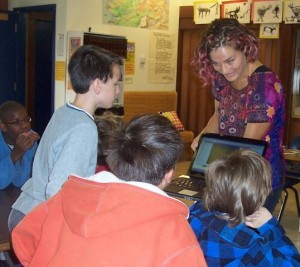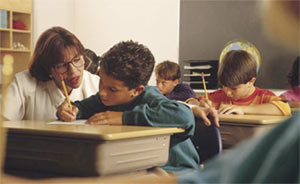Collaboration vs. Pull-Out Speech Therapy

Image source: speakandwrite.com.au
What is Pull-Out Speech Therapy?
The pull-out model of speech therapy refers to taking a child out of his usual classroom for speech therapy. This could mean either a group session or one-on-one work with the speech-language pathologist (SLP). For example, your child’s Individualized Education Program (IEP) might specify that he will receive two 30-minute speech therapy sessions per week. Using the pull-out model, he will leave his regular classroom to go meet with the speech therapist during these times.
Benefits of Pull-Out Speech Therapy
Pull-out speech therapy allows an SLP to work closely with the child in an environment with fewer distractions. Children who are best served with this model include those with severe speech disorders who require a great deal of one-on-one attention. Those who might be embarrassed about receiving extra attention in the classroom might also be better served with this model, along with those who learn best in a quieter setting.
Drawbacks of Pull-Out Speech Therapy
Pull-out speech therapy also has a few disadvantages. Children who are removed from their regular classrooms miss out on lessons. They must then rush to catch up with the rest of their classmates. Some children may also feel as though they are being singled out and their self-esteem may suffer.
In addition, pull-out speech therapy may not always lend itself to the child’s curriculum. Speech therapists and teachers may not collaborate as frequently to ensure that the child is learning skills in the speech room that may be applied in the classroom.
What is Collaboration Speech Therapy?
Collaboration speech therapy means that the child receives speech therapy treatment in his regular classroom. The SLP works with the teacher on classroom activities and teaching techniques. She is able to help the child follow along as the teacher instructs the class.
Benefits of Collaboration Speech Therapy
With this model, the SLP is able to work closely with the child’s teacher to ensure that he is applying speech therapy techniques to his communication in the classroom. She can also observe how the child interacts with his peers and tailor his speech therapy treatment according to his specific needs.
Children who receive speech therapy services within the classroom experience less disruption to their school schedules. They may be less likely to fall behind on classroom lessons. This model of speech therapy may also be useful for children who are gradually being phased out of individual speech therapy sessions once they meet their IEP goals.
Drawbacks of Collaboration Speech Therapy
Administering speech therapy services within the classroom does not readily lend itself to practice drills and one-on-one instruction. Children who need extra attention for a severe speech disorder may not receive the help they need. They may also become more easily distracted in a busy classroom setting.
Furthermore, not all school districts have the resources to implement this model of speech therapy. Many SLPs have large caseloads and they may be unable to work with a child in his regular classroom for an extended period of time.
The Bottom Line
In many cases, a child may benefit from combining both of these models. For example, Johnny could meet with the SLP twice weekly for individual or group speech therapy sessions. The SLP could also attend Johnny’s reading class in his regular classroom. This allows Johnny to practice his communication skills in various settings with the help of his SLP.
Each method of providing speech therapy services has its proponents and its critics. When considering these models, it’s important to remember the needs of the individual child. Just as not all speech therapy techniques are appropriate for all speech disorders, not all children learn the same way. Parents should meet with their child’s teacher and SLP to discuss how to best meet the child’s needs.




